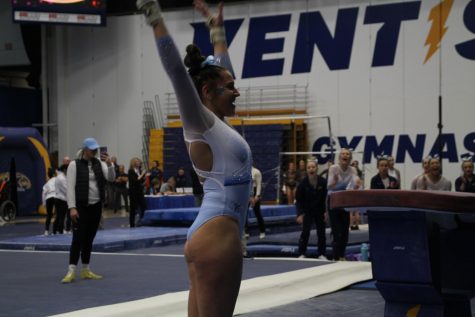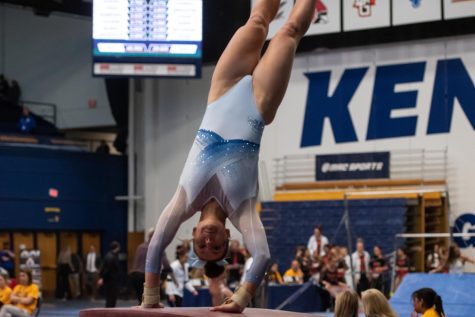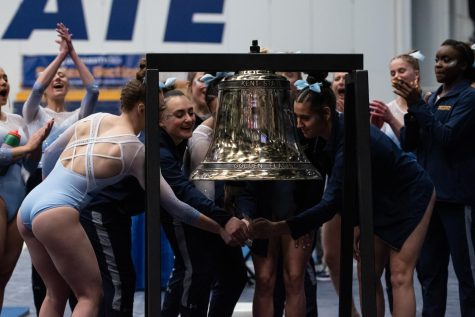Gymnastics for dummies
March 24, 2010
Gymnastics gets its recognition every four years as a spectacle in the Olympics.
Gymnastics gets its recognition every four years as a spectacle in the Olympics. Rarely though, does gymnastics grace the media like baseball or football.
This Saturday, the Kent State gymnastics team will travel to Bowling Green to compete in the Mid-American Conference Championships after winning the regular season MAC title. If
you decide to travel to watch the competition, here are five things you need to know about the sport:
var so = new SWFObject(‘http://www.staterinteractive.com/player.swf’,’mpl’,’376′,’282′,’9′);
so.addParam(‘allowscriptaccess’,’always’);
so.addParam(‘allowfullscreen’,’true’);
so.addParam(‘flashvars’,’&file=Gymnastics3223_600.flv&image=http://www.staterinteractive.com/gymnastics323.jpg&frontcolor=6666FF&lightcolor=EEEEEE&skin=http://www.staterinteractive.com/snel.swf&streamer=rtmp://flashmedia.kent.edu/fms-jmc/knn/’);
so.write(‘Gymnastics3223_600.flv’);
Check out four KSU gymnasts at work.
1. A perfect 10
A gymnast can score up to 10 points on a routine for each of the four events: floor, vault, bars and beam. The top five scores on each event are taken out of the six gymnasts who compete, and those scores are added to the team total.
Two gymnasts compete “exhibition,” and while the scores don’t count, the gymnasts compete to show their coaches what they’re capable of scoring during a competition.
Points are earned by including acrobatic skill sets as well as jumps and turns. Bonus tenths can be earned by placing these skills in direct succession with another, depending on level of difficulty. Tenths can be deducted for falling off the apparatus, losing balance, a leg separation, an arm bend or even a rhythm break in the routine.
Routines are performances. Exclusion of necessary elements or lack of composure results in low-scoring routines.
“When it comes to scoring, judges can take off for anything, bent legs, body positioning, stuck landings,” senior Carly Conroy said.
Most team victories are decided by merely tenths of points. For example, one fall off the beam costs five-tenths and can result in the loss of a competition entirely.
In the Flashes’ meet against Kentucky on March 5, Kent State lost by one tenth. Had Kentucky fallen on one routine, Kent State would have won.
For the best teams, all five counting scores must exceed a 9.8. The skill level required to prevent deductions is accomplished by years of intense training and dedication.
2. Don’t boo the judge
Unlike other sports where a coach can throw a flag down to protest a call by a referee or umpire, the challenging of a gymnast’s score is much more particular.
Judges are relatively unapproachable. Nine times out of 10, challenging a score will do no good, and on the off chance the judge made a mistake, only a few tenths (maximum) can be awarded back to the gymnast.
“There’s no instant replay,” senior Lydia Barrett said. “There’s nothing you can really do to change what they saw other then inform them what’s in the routine, but it’s up to them. The judges do check each other, if there’s a huge difference, then something wasn’t counted by one judge.”
A gymnast’s routine can be left to interpretation. A judge may miss a skill the gymnast performs, thus creating problems for a coach who knows the gymnast’s routine beginning to end.
“Really there’s not a lot you can do,” Kent State coach Brice Biggin said. “Inquiries are when the judges’ scores are drastically different or if there’s an occurrence where they might have not given credit for something.
“The only real way to approach them is by giving them looks. Certainly astonishment, disbelief or complete utter disdain for what they put up there. I’ve been known to do that a lot in my career. And most judges know that and just don’t look at me.”
If routines don’t build, the judge won’t grant a gymnast the benefit of the doubt. On a full turning jump, she may have barely missed 360 degrees, but if the judge isn’t feeling accommodating, the gymnast will not receive full credit. However, if the gymnast does not give reason for the judge to deduct and the judge still does, a challenge may be placed in on the routine.
“It’s all about discretion,” senior Brittany Kopp said. “For a bent knee, they can take up to a tenth, some will take a half a tenth. Some will take the full tenth every time.”
3. Why did she only compete on floor?
In club gymnastics, gymnasts are required to compete in all events, but in college gymnastics, event specialists are more common than all-around competitors. A gymnast can be recruited for being an excellent beam worker or based on her abilities on a combination of events.
Having many event specialists can provide invaluable depth when a teammate is sick, injured or doesn’t warm up well. The ability to put out six solid routines that can score the highest is pivotal in winning meets.
“In gymnastics it’s so different, we have 20 girls and the top six compete on each event,” Biggin said. “Not all the girls are on the same level as far as expertise. We want to find a team where we have eight, nine, 10 girls who can go up at any time and throw a great routine.
“That’s the easiest way to win championships — with good depth.”
4. It’s all about the team
While gymnastics appears to be an individual sport, in college gymnastics, it’s all about the team. Each gymnast competes individually, but each gymnast also depends on her teammate before to build the scores. Scores should technically increase from gymnast to gymnast in the lineup.
The most difficult and solid routines will compete last, and if the previous gymnasts are successful in hitting their routines, the last gymnast will more likely have the highest score possible. If a judge sees a series of falls or unclean routines, he or she will not expect the next gymnast to execute and will not give her the benefit of the doubt on the skills in her routine.
It’s unfair. But that’s the sport of gymnastics: It’s imperfect and competitive.
“If someone goes before you and gets a high score, if you go up and do that much better, they technically have to give you a better score,” Conroy said. “You have to make individual sacrifices if you’re having a bad day. The easiest thing to do is let yourself fall, but you can’t do that, you have to find confidence and go for it. You have to push to hit.”
“Everything you do affects someone else,” Barrett said. “If someone doesn’t do well in front of you, that puts that much pressure on you. We try to build a family atmosphere where everyone behind you is pushing you. It’s individual when you’re up there, but it’s about the team at the end of the day.”
5. Yes, she has to dance
Gymnastics is comprised of many elements, mostly rhythmic and acrobatic. The sport is intended to look polished, flawless, delicate, strong and easy. The most successfully artistic gymnasts can combine all of these characteristics into one routine, and, if they’ve scored well, you can tell if they have.
“Gymnastics is artistic, so part of some of the deductions the judges can take are within the choreography,” assistant coach Sharon Sabin said. “Are skills artistic? Are skills dynamic? If we didn’t do any dance, we’d be like men’s gymnastics. So that gives a feminine touch to the sport. Yes, we can do all these skills, the other side to that is the flexibility. Their personalities come out in the dance. We work with the girl’s strengths.”
The dance moves break up skill sets and give the gymnast a break between, for example, her flight series (the flips) and the jump series. Dance is designed to make the routine flow. Especially on the beam, where the gymnast needs to move to different sides to ensure she has enough room to complete the required skills.
Contact sports reporter Katie Corbut at [email protected].




















